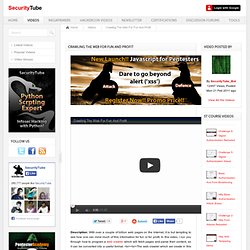

Quantum networks may be more realistic than we thought. The quantum Internet is a term that has been bandied about a lot recently. And, for the moment it is utter nonsense. The Internet connects computers, so the quantum Internet pre-supposes the existence of useful quantum computers. The Internet also involves arbitrary on-the-fly routing through many intermediate stations, while current quantum communications protocols rely on point-to-point connections.
I can't think of anything less Internet-like than that. The nice thing about buzzwords, though, is that some people take them seriously while also recognizing the problems inherent to the idea. Quantum static on your phone line The issue boils down to the very nature of the quantum state. To expand that range, you need to entangle qubits at distant locations. The process of entangling two photons is, however, not always successful. Spreading your bets on photon survival This would all be so much easier if the quantum state was stored across multiple photons. But wait, it's a router too. The Secrets of the Log Periodic Antenna. Designing Log Periodic Antennas By Glen Dash, Ampyx LLC, GlenDash at alum.mit.edu Copyright 2000, 2005 Ampyx LLC Lightweight and precise, the log periodic has become a favorite among EMC engineers.

In 1957, R.H. DuHamel and D.E. The log periodic antenna works the way one intuitively would expect. Figure 1. Log periodic designs vary, but the one most commonly used for EMC work is the Log Periodic Dipole Array (LPDA) of Figure 1 invented by D.E. Figure 2: A closer look at the LPDA. The basic geometry is that shown in Figure 2.. Two factors, tau (t) and sigma (s), are for the most part the only factors we need to consider. Tau and sigma can be selected by using Figure 3 (Ref. 1, 3). Figure 3: The parameters tau and sigma can be chosen from this graph. In operation, the LPDA works as follows. Having chosen tau and sigma, we simply plug in the numbers. Now comes the tricky part. This equation deserves some explanation. We have chosen to make the antenna elements from 1/4 inch rods.
Crawling the Web for Fun and Profit Tutorial. Description: With over a couple of billion web pages on the Internet, it is but tempting to see how one can mine much of this information for fun or for profit.

In this video, i run you through how to program a web crawler which will fetch pages and parse their content, so it can be converted into a useful format. <br><br>The web crawler which we create in this tutorial, consists of mainly 2 parts:<br> Tags: programming , Disclaimer: We are a infosec video aggregator and this video is linked from an external website. SitePoint : New Articles, Fresh Thinking for Web Developers and. Tech collective » Kismet Log Viewer (KLV) Download: kismet-log-viewer-0.9.7.tar.gz (14k) Intro: The Kismet Log Viewer (KLV) takes Kismet .xml log files and produces a nicely formatted html interface to browse the logs with.

KLV has the ability to utilize available GPS information to create links for external maps via the net, and provides the ability for those with Snort to generate a page of Snort output for each specific bssid that has data available. KLV also comes with my Kismet Log Combiner script to help users consolidate multiple .xml and .dump log files. Over time I will continue to add more features until I can’t think of anything else useful to add. Example: An example of KLV’s output is now available to view thanks to Morticus of #kismet. > View Example Output (utilizes the .dump file via the -snort option) Requires: Perl 5.x or above. Download: > kismet-log-viewer-0.9.7.tar.gz (14k) Install: tar -xpzvf the archive then open klv.pl in your fav editor to set up vars and see instructions. ChangeLog: Help & About: